|
 Russula griseobrunnea Russula griseobrunnea
BiostatusPresent in region - Indigenous. Endemic
Images (click to enlarge)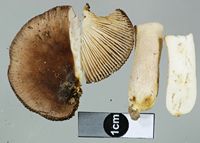
Owner: J.A. Cooper | 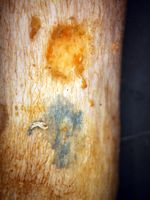
Caption: Upper: FeSO4. Lower: guaiac
Owner: J.A. Cooper | 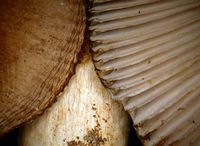
Caption: cap,, gills and stem details
Owner: J.A. Cooper | 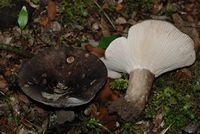
Owner: J.A. Cooper | 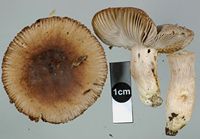
Owner: J.A. Cooper | 
Owner: J.A. Cooper | 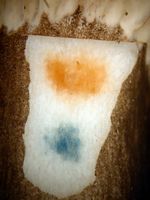
Caption: Upper: FeSO4. Lower: guaiac
Owner: J.A. Cooper | 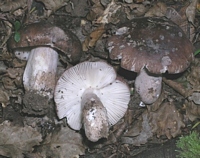
Owner: J.A. Cooper | 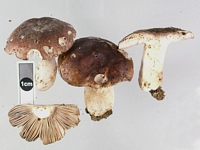
Owner: J.A. Cooper | 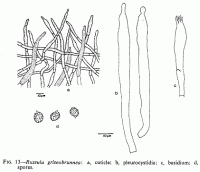 | 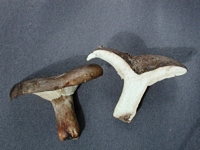
Caption: fruitbody
Owner: J.A. Cooper | 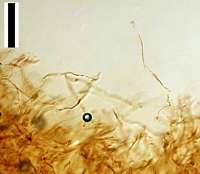
Caption: scale = 50um. Dermatocystidia in SV
Owner: J.A. Cooper | 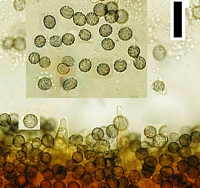
Caption: scale = 20um. Spores and cheilocystidia
Owner: J.A. Cooper | 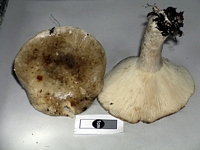
Owner: J.A. Cooper | 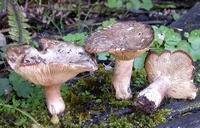
Owner: P. Leonard | 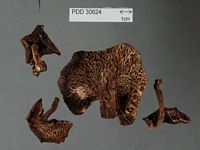
Caption: Dried type specimen
Owner: Herb PDD | 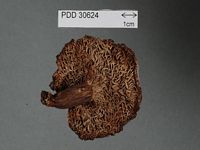
Caption: Dried type specimen
Owner: Herb PDD | 
Owner: J.A. Cooper | 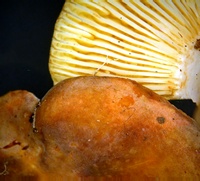
Owner: J.A. Cooper | 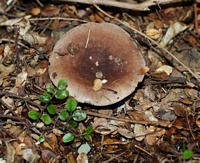
Owner: J.A. Cooper | 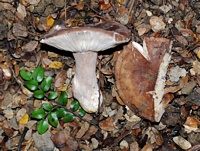
Owner: J.A. Cooper | 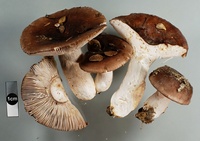
Owner: J.A. Cooper | 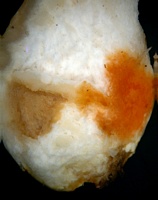
Caption: left: guaiac. Right: FeSO4.
Owner: J.A. Cooper | 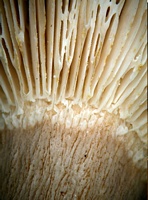
Caption: gills and stem apex
Owner: J.A. Cooper | 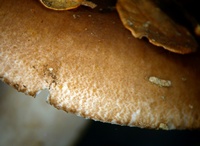
Caption: cap
Owner: J.A. Cooper |
Article: McNabb, R.F.R. (1973). Russulaceae of New Zealand. 2. Russula Pers. ex S.F. Gray. New Zealand Journal of Botany 11(4): 673-730 (http://www.rsnz.org/publish/abstracts.php).
Description: pileus: 4.5-11 cm diam., hemispherical to convex
when young, centrally depressed to infundibuliform at maturity, viscid under
wet conditions, glabrous, often faintly creviced or finely rugulose, innately
pruinose to finely felted under lens, velar remnants absent, greyish brown,
dark greyish brown, or pallid sepia, often with a sooty appearance; margins
entire, thick, non-pectinate. Cuticle 150-200 µm thick, partially gelatinised
at maturity, composed of obliquely ascending, interwoven hyphae and pilocystidia;
hyphae thin-walled, septate, 3.5-6.5 µm diam., with dark brown contents in KOH,
terminal cells unspecialised; pilocystidia numerous, ± cylindrical with
acuminate, capitulate, or strangulate apices, thin-walled, contents refractive
in KOH, 70-120 X 5-9 µm. lamellae: adnate to subdecurrent, crowded, moderately
thick, simple or occasionally forked near stipe, to 8 mm deep, pallid creamy
white when young, becoming cream to pallid creamy ochraceous, occasionally discoloured
in places ,at maturity, lamellulae numerous, in 3 unequal series, typically
in sequence. stipe: 3-5 cm long, equal or tapering basally,
1.2-2.5 cm diam., solid, dry, glabrous, faintly pruinose under lens, concolorous
with pileus or slightly paler; flesh pallid brownish grey, slowly darkening
on prolonged exposure to air. Cuticle composed of parallel to interwoven, thin-walled,
septate hyphae 3.5-6.5 µm diam., with dark brown contents in KOH; caulocystidia
numerous, similar to pilocystidia. spores: spore print white; spores broadly elliptical to obovate, obliquely
apiculate, apiculus to 1.5-(2) µm long, 7-9-(10.5) X 6-8 µm, ornamentation of
amyloid verrucae to 0.5 µm high, in confluent groups, joined by fine amyloid
ridges and forming a partial reticulum, or occasionally isolated; plage indistinct.
hymenium: basidia hyaline, clavate, 36-60 X 7.5-10.5
µm, 4-spored, sterigmata to 7 µm long; pleurocystidia scattered, numerous, broadly
fusiform or subclavate, apices acuminate, strangulate, or capitulate, hyaline,
thin-walled, contents refractive in KOH, projecting to 25 µm beyond basidia,
60-110 X 6-12 µm, cheilocystidia similar to pleurocystidia but shorter. hymenophoral
trama: heteromerous, intermixed. context of pileus: pallid, greyish white, firm, darkening
on prolonged exposure to air; structure heteromerous, clamp connections absent:
taste: lamellae and context mild. chemical characters: Formalin on context—faint pink to salmon
pink; phenol on context—slowly deep vinaceous; FeSO4 on context—pallid salmon
pink; guaiacol on stipe base—rapidly salmon pink, darkening to orange-red; KOH
on pileus—darkening; on context —n.r.; NH4OH on pileus—darkening; on context—n.r.
Habitat: Solitary or gregarious under Nothofagus.
Notes: The firm context which slowly darkens on exposure to air and regularly arranged
lamellulae indicate that this species belongs in section Compactae, subsection
Compactae, as defined by Shaffer (1962).
Russula griseobrunnea may be distinguished from the other New Zealand representative
of subsection Compactae by the slowly darkening context, mild taste,
and salmon pink reaction to FeSO4
|